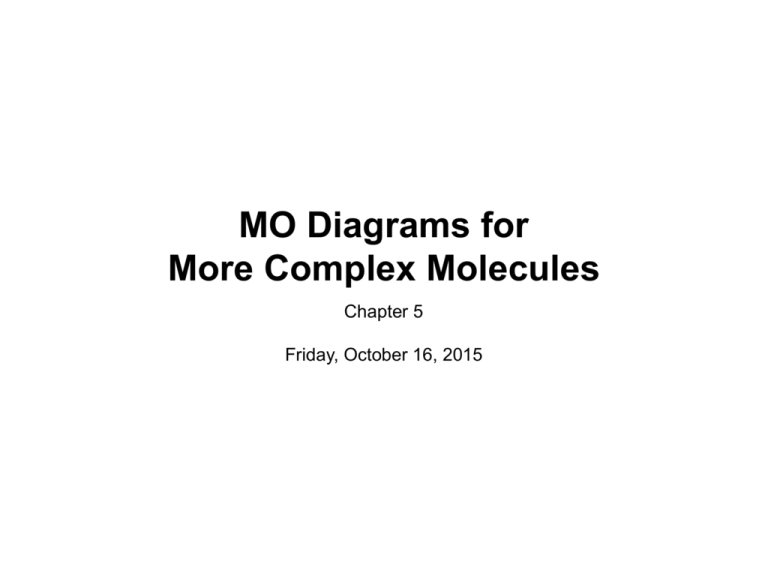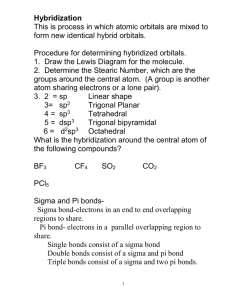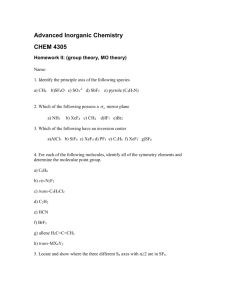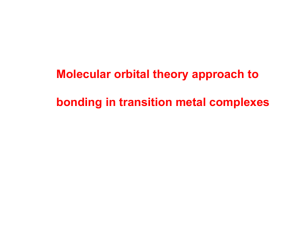Document
advertisement

MO Diagrams for More Complex Molecules Chapter 5 Friday, October 16, 2015 BF3 - Projection Operator Method boron orbitals 2s: A1’ E’(y) E’(x) 2py: A1’ E’(y) E’(x) A1’ E’(y) E’(x) 2px: A2’ E’(y) E’(x) A2’’ 2pz: A2’’ E’’(y) E’’(x) BF3 - Projection Operator Method boron orbitals 2s: A1’ E’(y) E’(x) A1’ 2py: A1’ E’(y) E’(y) E’(x) little overlap 2px: A2’ E’(y) E’(x) E’(x) A2’’ 2pz: A2’’ E’’(y) E’’(x) Boron trifluoride F 2s is very deep in energy and won’t interact with boron. B Li –8.3 eV Na C –14.0 eV N B 2p Al O F 1s C Si P Mg Be H Al –18.6 eV Ne 2s He Si S 3p 3s Cl P S N Cl Ar O –40.2 eV F Ne Ar Boron Trifluoride σ* E′ σ* π* –8.3 eV a2″ Energy A2″ –14.0 eV A2′ + E′ A1′ nb A2″ + E″ –18.6 eV A1′ + E′ π a2″ σ σ a1′ e′ A1′ + E′ nb –40.2 eV d orbitals • l = 2, so there are 2l + 1 = 5 d-orbitals per shell, enough room for 10 electrons. • This is why there are 10 elements in each row of the d-block. σ-MOs for Octahedral Complexes 1. Point group Oh The six ligands can interact with the metal in a sigma or pi fashion. Let’s consider only sigma interactions for now. 2. pi sigma σ-MOs for Octahedral Complexes 2. 3. Make reducible reps for sigma bond vectors 4. This reduces to: Γσ = A1g + Eg + T1u six GOs in total σ-MOs for Octahedral Complexes 5. Find symmetry matches with central atom. Γσ = A1g + Eg + T1u Reading off the character table, we see that the group orbitals match the metal s orbital (A1g), the metal p orbitals (T1u), and the dz2 and dx2-y2 metal d orbitals (Eg). We expect bonding/antibonding combinations. The remaining three metal d orbitals are T2g and σ-nonbonding. σ-MOs for Octahedral Complexes We can use the projection operator method to deduce the shape of the ligand group orbitals, but let’s skip to the results: L6 SALC symmetry label σ1 + σ2 + σ3 + σ4 + σ5 + σ6 A1g (non-degenerate) σ1 - σ3 , σ2 - σ4 , σ5 - σ6 T1u (triply degenerate) σ1 - σ2 + σ3 - σ4 , 2σ6 + 2σ5 - σ1 - σ2 - σ3 - σ4 Eg (doubly degenerate) 5 4 3 2 16 σ-MOs for Octahedral Complexes There is no combination of ligand σ orbitals with the symmetry of the metal T2g orbitals, so these do not participate in σ bonding. L + T2g orbitals cannot form sigma bonds with the L6 set. S = 0. T2g are non-bonding σ-MOs for Octahedral Complexes 6. Here is the general MO diagram for σ bonding in Oh complexes: Summary MO Theory • MO diagrams can be built from group orbitals and central atom orbitals by considering orbital symmetries and energies. • The symmetry of group orbitals is determined by reducing a reducible representation of the orbitals in question. This approach is used only when the group orbitals are not obvious by inspection. • The wavefunctions of properly-formed group orbitals can be deduced using the projection operator method. • We showed the following examples: homonuclear diatomics, HF, CO, H3+, FHF-, CO2, H2O, BF3, and σ-ML6








